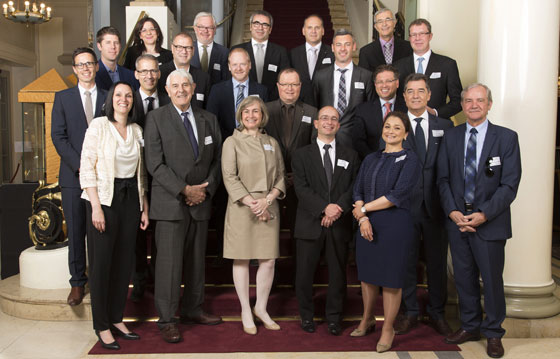
The Employers’ Federation of the Watch and Microtechnology Industries (Association Patronale de l’Horlogerie et de la Microtechnique, APHM) celebrated its centenary on 20 June, day of its creation a century ago. A major player in the watch industry, the Bienne-based institution serves its members and vigorously supports professional training.
The APHM celebrated its one hundredth anniversary at Bern’s Bellevue Palace. The association’s president, Carole Décosterd, recalled the highlights of ten decades of struggles and negotiations. Swiss Council of States member and former mayor of Bienne Hans Stöckli painted a picture of the history of watchmaking and the economic crises it has faced over the past century.
In the 19th century, the development of traditional watchmaking, characterised by home workers and watch assembly workshops, changed and began to acquire an industrial dimension. This led to the creation of the first major watch brands. At that time, the industrial fabric of watchmaking consisted of a multitude of SMEs active in the industry’s different professions, such as manufacturers of cases, movement components and finished watches. Industrialisation and the concentration of multiple workforces in a single location coincided with the advent of the industrial revolution on the world stage and the first social conflicts between employers and workers.
Originally intended to come to the assistance of sick, injured or jobless workers, trade union associations became radicalised and fought to improve the social standing and emancipation of the working classes. Employers reacted and, to form a collective response to the demands of trade unions, joined together to create the «Association cantonale bernoise des fabricants d’horlogerie» (ACBFH) on 20 June 1916. Its aim was to defend the adoption of common standards and guarantee the quality of production and sales practices. The ACBFH was founded by the leaders of three large companies based in the region: Paul-Emile Brandt (Omega), Henri Frédéric Sandoz (Tavannes Watch) and Baptiste Savoye (Longines).
The reasons that led these three industrialists to form the ACBFH had to do not only with economics, but also industrial relations: in the latter case, with the industrialisation of production, workers tended to form trade unions in order to demand better salaries and social conditions, as well as improved everyday working conditions. For example, between the summer of 1914 and the winter of 1918, the price of bread rose by 108%, sugar by 195%, potatoes by 93% and beef by 122%. Under the auspices of the «Fédération des ouvriers sur métaux et horlogers» (FOMH), workers therefore demanded wage increases to bring their incomes into line with the cost of living. Meanwhile the economic situation, linked to the fragmentation of subcontracting units, created unhealthy internal competition between these small workshops, leading to a sharp reduction in the price of watch components. To combat this trend and push prices back up, workshops joined together to form small sectoral associations. These difficulties encouraged watch manufacturers to unite for their part in an umbrella association whose role in particular was to negotiate supply contracts with their subcontractors. It was in this tense and complicated socio-economic context that Longines, Omega and Tavannes Watch created the ACBFH.
Key struggles led by the ACBFH included an agreement on shorter working hours, which saw a reduction in weekly hours from
58.5 to 52.5 in 1919. The institution also made a major contribution to negotiations leading to the creation of the Collective Labour Agreement (CCT) which came into force on 15 May 1937. It was signed in an unusual economic context, filled with tensions and early signs of a second global conflict. Peace nonetheless gradually took hold in the workplace and social partnerships were formed to the advantage of workers and industrialists alike, thanks to a sense of fairness, reality and compromise.
In the years after its foundation, the activities of the ACBFH focused essentially on the canton of Bern, which had long been the most important watchmaking region in terms of manpower. The economic reality of the late twentieth century and the need to adapt to the requirements of new member firms saw the ACBFH extend its activities to other watchmaking cantons, mainly Neuchâtel and Jura, and to a lesser extent Fribourg, Geneva and Ticino. This move brought about a change of name for the institution, which in August 2000 became the «Association patronale de l’horlogerie et de la microtechnique» (APHM).
As was the case with the ACBFH for 84 years, the APHM continues to defend the interests of its members, the watch industry generally, and the new high-tech companies that have affiliated with it. The institution is also a key player in the field of vocational training and is involved in various ways in all aspects relating to this activity.
A faithful «travelling companion» to the national watchmaking industry, the APHM today has 106 affiliated companies, representing around 13,000 employees. Over the next century it will continue to support and guide its members on the path of prosperity, showing respect and consideration for all stakeholders.
July 07, 2016


 News
News